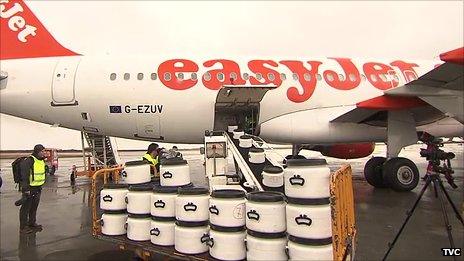Easyjet to conduct volcano ash cloud tests
- Published

The Eyjafjallajokull eruption caused the largest closure of European airspace since World War II
A tonne of volcanic ash has been flown from Iceland to Luton airport in readiness for a "unique experiment" to test an aircraft warning system designed to detect ash clouds.
Ash from the Eyjafjallajokull volcano, which caused travel chaos in 2010, will be dispersed into the atmosphere in "controlled conditions".
An Easyjet flight equipped with the system then aims to measure the hazard.
The airspace for the August testing is yet to be confirmed.
The Eyjafjallajokull eruption in April 2010 caused the largest closure of European airspace since World War II, with losses estimated at between 1.5bn and 2.5bn euros (£1.3-2.2bn).
The plane will carry the AVOID (Airborne Volcanic Object Imaging Detector) system, which has been developed by Easyjet, Airbus and scientists from the Norwegian Institute for Air Research (NIAR).
Technology 'crucial'
Ian Davies, engineering director for Luton-based Easyjet, said: "The threat from Icelandic volcanoes continues so finalising approval of the AVOID technology is as crucial now as ever, to ensure we never again see the scenes of spring 2010 when all flying ceased for several days.
"It means that in the event of another eruption and ash coming down over Europe we'll be able to determine where it is and fly in areas that are absolutely safe."

The ash, dried to create the consistency of fine talc and transported in tubs, will be used in the experiment planned for this summer
The AVOID system uses a dual-camera system that "sees" the ash particles in the atmosphere in order to alert pilots to take evasive action. If sucked into the plane's engine they can melt and clog the equipment.
Dr Fred Prata, a senior scientist from NIAR, said: "One aircraft will sprinkle about a tonne of ash into the atmosphere and another will come at it from a distance with our instrument mounted onboard and see the cloud.
"We think if aircraft are equipped with this equipment they'll be able to take action to go around it quite safely."
- Published8 May 2013
- Published8 December 2011
- Published2 December 2011
- Published24 May 2011